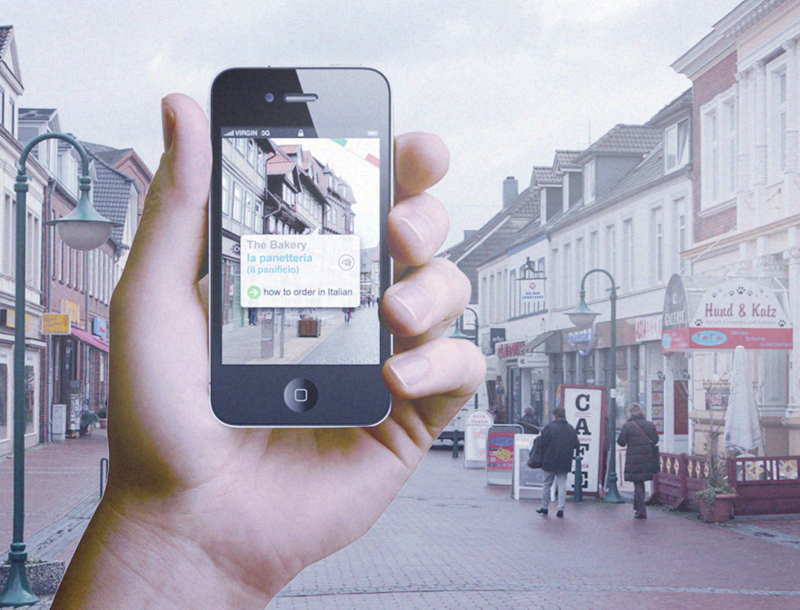Major tech publications like TechCrunch recently called augmented reality (AR) the best way to prevent the drop in retail sales during the lockdown.
We couldn’t agree more.
Not only that, AR is a great way to make shopping more engaging, exciting, and personalized. Having the ability to try products increases the confidence to buy and makes the entire shopping process much more convenient for customers. Not to mention that they can even try products without leaving their homes.
In this post, we’re exploring the major benefits of using AR in retail. For those considering using this technology to engage customers, we’ll list three types of AR applications.
What is Augmented Reality?
Augmented reality (AR) is an interactive 3D view of the real world with computer-generated vision using visuals, sounds, and other sensory stimuli. AR aims to overlay digital content and information onto the physical world and enhance its parts with user-generated input.
In retail, augmented reality is used to improve customer experience in many ways. The most famous one is “try-before-you-buy,” where AR visualizes a product on a background set by a customer. The applications of this method range from trying furniture pieces at home to trying on glasses online.
The industries where AR in retail has been applied to enhance customer experience include automotive, furniture, makeup, shoes, home goods, technology, grocery, and apparel. As Deloitte shows, AR is useful where there’s an opportunity for product try-on and customization.
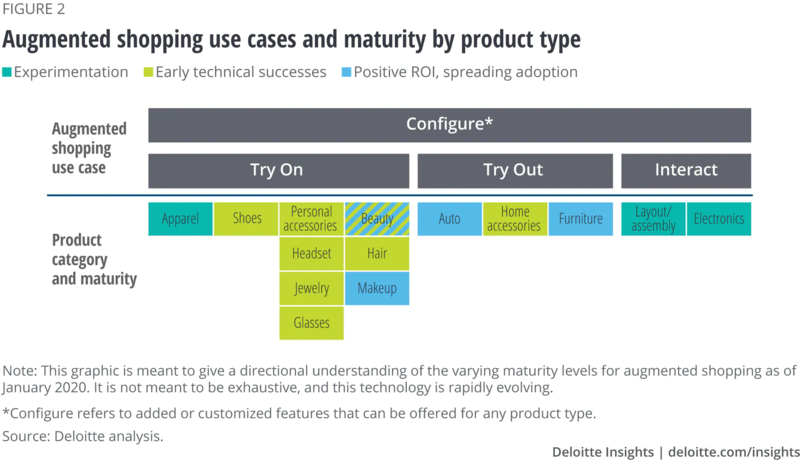
Source: “Augmented shopping: The Quiet Revolution” report, Deloitte
Read more: How Does Augmented Reality Work? [Compete Guide]
Benefits of Augmented Reality in Retail
Using AR in retail benefits both the business and the customer.
Benefits For Customers
For customers, the technology presents an opportunity to try products without leaving their homes, which proved to be a good idea during the pandemic. Besides, having an AR try-on means customers have the freedom to try literally everything when they want, how they want it.
Example: Warby Parker, an eyewear brand, designed a virtual try-on app for safe online shopping. In the brand’s COVID-response, the app is recommended to shop without limits while staying home.
Also, customers loved their experience with trying glasses with AR. The iOS version of the Warby Parker application has a whopping 4.9-star rating from 193,830+ users and tons of positive reviews.
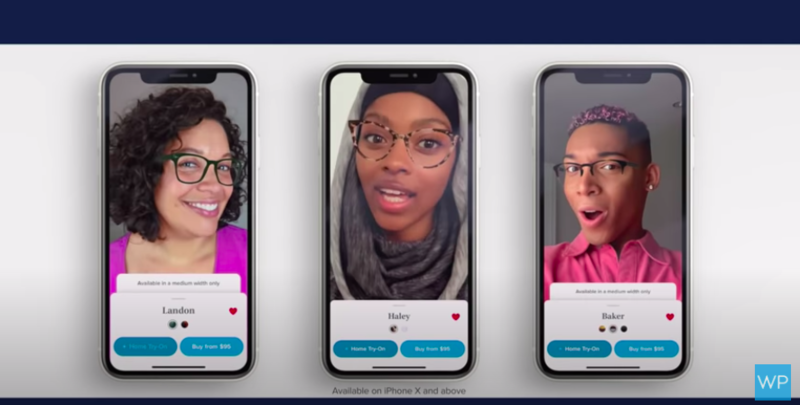
Source: YouTube, Warby Parker
Product search with AR isn’t limited to small products like glasses. Many furniture retailers have been using the technology to allow customers to visualize how products like sofas and chairs would look like in their homes.
Thanks to AR-enabled apps, customers place 3D versions of products into their homes for previews. They can virtually stand in the newly designed space and get a feeling of the real design, which is something many shoppers appreciate.
Ashley Furniture is one of the retailers taking advantage of the technology. The brand’s mobile app allows previewing thousands of items from categories like dining, lighting, home office, bedroom, mattresses, storage, and even wall accents.
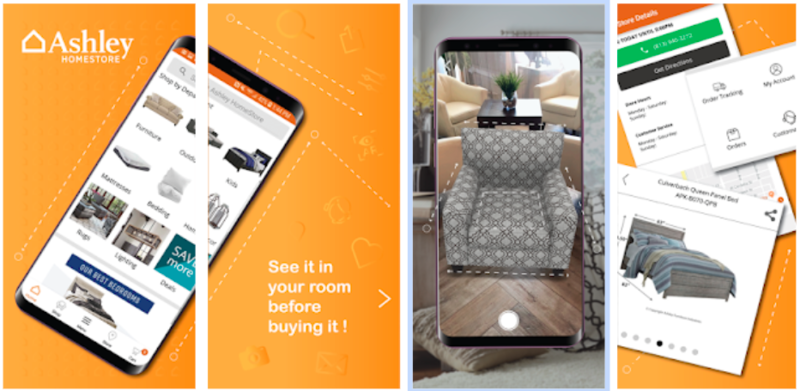
Source: Google Play, Ashley Furniture
Benefits for Retailers
Using AR in retail presents a wide range of benefits for businesses.
With more customers expecting the technology to be a part of their shopping experience, many businesses have started exploring the benefits and investing in AR app development. In fact, Gartner’s research suggested that 46% of retailers are planning or have already deployed AR.
Here’s the full list of benefits those retailers can get:
-
Higher customer engagement — AR in retail offers an interactive, fun experience that lets customers customize and try on products while managing the experience. The element of interactivity engages customers more than the traditional shopping experience.
-
Educating customers about products — AR in eCommerce allows delivering product information in new ways to increase customer knowledge. For example, a virtual try-on can display various tips to help customers make the best choice.
-
Fewer returns — Trying products before buying them ensures that the customers make a more informed decision to purchase. So, they will be less likely to submit a return.
-
Higher sales — AR can help sell more. The mentioned Deloitte research described cases where retailers could achieve conversion rates of up to 69% within AR apps. Product customization and preview were among the main reasons for such an impressive performance.
-
Word-of-mouth — Augmented reality in retail offers experiences that customers can easily share on social media. This way, businesses can spread the word about their technology, products, and marketing offers in an organic way.
-
Customer research — Businesses can study customer use of AR and define specific features that customers prefer. This information can help develop better products or improve existing ones.
All these benefits also contribute to the image of an innovative, customer-first company. This is something that many brands are actively pursuing, and AR is seen as a good strategy to achieve this goal.
Types of AR Applications in Retail
Many retailers, especially in the apparel and makeup niches, have introduced different AR apps to improve customer engagement and experience. But we can differentiate three major types among them: web-based, in-store, and mobile apps.
Let’s take a closer look at each one.
1. Web-Based Apps
A web-based AR app scans and tracks a customer’s body (or a part of it) and movement to allow them to try virtual clothing. Basically, a computer screen becomes a huge AR mirror where customers can see how products look on them in real time.
Web-based apps are often made into large screens in brick-and-mortar retail locations. A customer can activate the app by touching the screen and choose an item to try on. The process is super fast, and customers can easily adjust various product details like colors.
Many retailers also make web-based apps available on their websites. Ray-Ban’s Virtual Mirror is one of the most popular ones. The app uses the customer device’s camera to act as a virtual mirror.
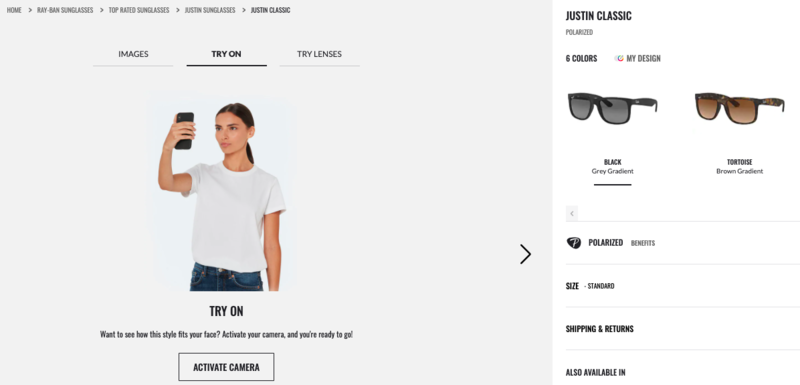
Ray-Ban Virtual Mirror. Source: Ray-Ban
2. In-Store Apps
Retailers also use AR to personalize customers’ in-store experience. The most famous example is an “augmented mirror” that allows them to try clothing virtually in the dressing room.
This way, businesses improve customer experience by reducing the time to decide if an item fits. So, people can try more clothing very quickly, which speeds up the product research and mixing and matching process.
Another way in-store apps improve customer experience is an opportunity to try on products without having to remove the items they’re wearing. This aspect adds convenience and makes shopping easier.
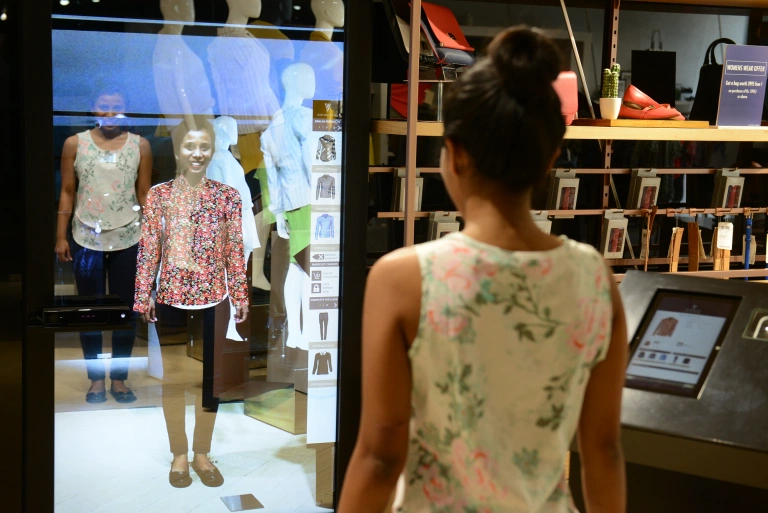
An in-store AR mirror. Source: Hemant Mishra/Mint via Getty Images, retrieved from Observer
3. Mobile Apps
Mobile apps are essentially the use of the same AR principle on mobile devices. Through a handheld device like a smartphone or tablet, customers can view the environment in 3D and add products through built-in cameras.
We’ve already cited a few examples of mobile apps using AR in this article, including Ashley Furniture and Warby Parker. The value of such apps has been great, as they enjoyed millions of installs and tens of thousands of positive reviews.
The biggest advantage of having an AR app for a retailer is the convenience it provides for customers. They can download and start using an app within minutes rather than going to the store to try products. That’s why many retailers have become increasingly interested in AR for marketing and shopping in the times of the COVID-19 pandemic.
Here’s one more example: Wanna, a fashion retailer, has an AR app to try on sneakers. The users can try products instantly on their feet and take photos.
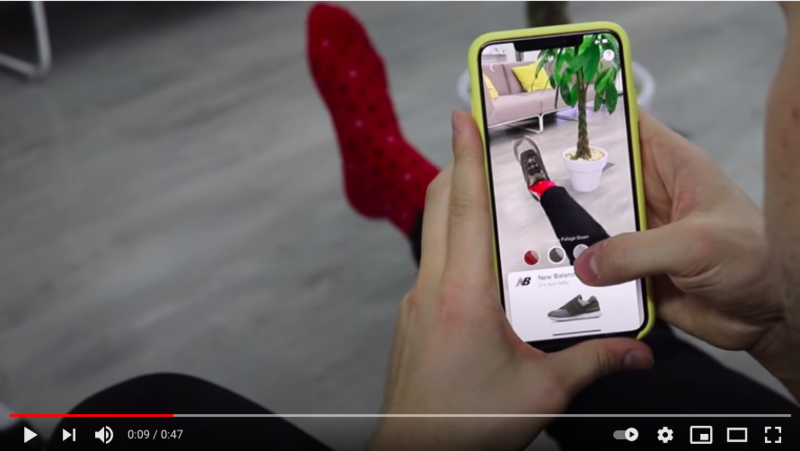
Source: YouTube, “Wanna Kicks - Explore new sneakers in AR!”
Augmented Reality in Retail: Summary
Customers who tried AR in retail once will look forward to using the technology again. They appreciate the freedom of product customization and trying, which improves their experience and engagement with brands.
Offering an AR app to customers can be a major competitive differentiator and a new way to increase sales and customer engagement. With the technology being readily available, AR app development is now much easier and affordable for many businesses.

